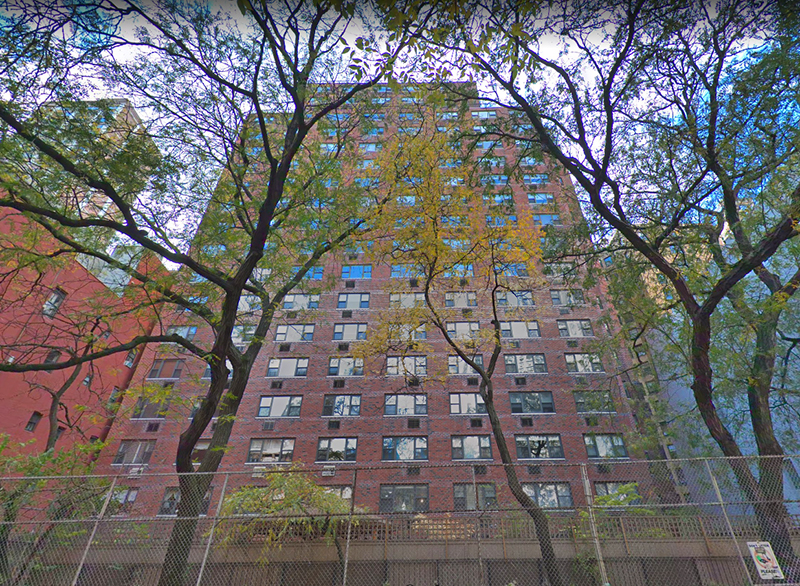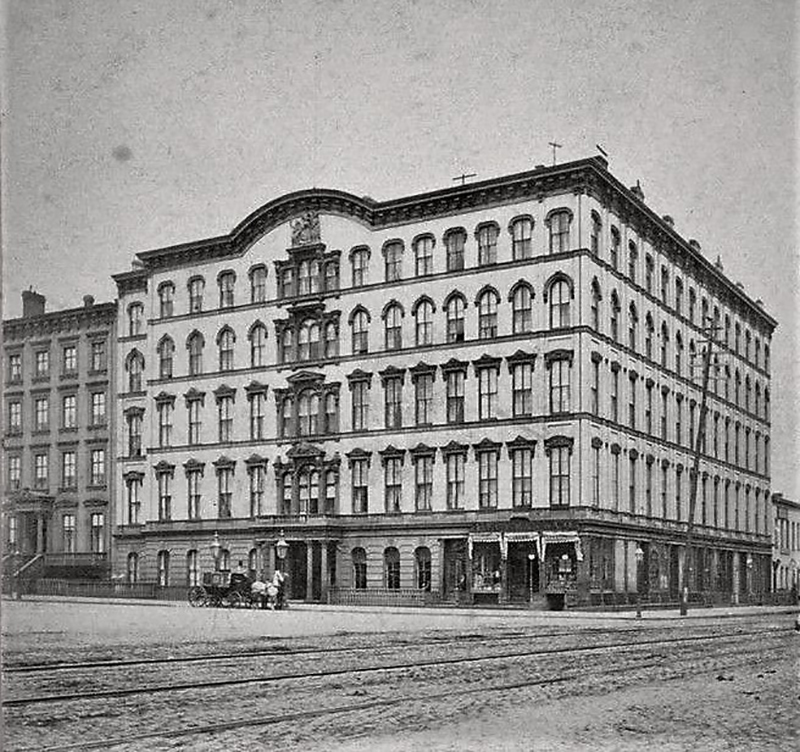|
|


The 1880 U.S. Census for the County of New York (which is contiguous with Manhattan) shows the Nicholas Hart family living in an apartment at 312 East 73rd Street on the Upper East Side. (Their census page doesn't specify "East," but other pages in the same section of the same Census book do.) The address no longer exists, but if it did, it would be approximately where this brownstone stands (inset). The parents are Nicholas, 46, a miller, born in England; and Rossana, 41, housewife, born in Ireland. William's listed age is 16 — 1880 minus 1864 is 16 — but he was born in December of 1864, and the Census was taken in June of 1880, when he was only 15½. His siblings — three girls — are Nettie, 18, a dressmaker, born in New York; Frances, 11, born in Illinois; and Bill's favorite little sister Mary Ellen, 8 (Illinois), whom he would care for later in life. We're unsure where this address fits into Bill's timeline. It doesn't seem to appear in secondary sources, including Bill's own autobiography. The family was extremely poor. Nicholas traveled from town to town in New York and throughout the Midwest building and repairing flour mills. The family traveled with him until about this time (1880) when Rosanna took ill and Nicholas sustained an injury that rendered him incapable of working for several weeks. After that, the family remained in New York, regardless of where Nicholas' work took him. It's notable that Frances and Mary Ellen were in school. Bill didn't have much formal schooling because, he says in his autobiography, the family couldn't afford books. Instead he supplemented the family income by taking jobs as a messenger — as noted in the Census — for hotels, a butcher, a tailor and other local business concerns wherever they lived in the New York area.
Where they lived in New York was a lot of places. Perhaps they lived at 312 East 73rd Street before they landed at the Everett House, 37 East 17th Street in Gramercy Park, where they remained for a relatively long time — two years. Bill writes in his 1929 autobiography, "My Life East & West" (pp. 81-82):
The Everett House, at Seventeenth Street and Fourth Avenue, and the Clarendon Hotel, one block above, were under the same management. The former was my home
for the next two years. I was the messenger boy for both hotels. My duties were to make two trips daily to the general post office for mail, and do such other errands
as were required between the hours of 7 a.m. and 7 p.m. My salary was seven dollars and twenty cents a month. Carrying messages for guests when not performing
my usual duties raised this amount considerably. The telephone had not yet been extensively installed.
They were lucrative days for the messenger boys. I quite frequently did errands for the hotel clerks and bartenders, and in return they gave me passes for theaters. ... I once carried a huge bouquet for Clara Morris to Sarah Bernhardt on her opening at Booth's Theater. The Madame pinched my cheeks and said, "How red they are." Young Bill was so capitivated by the people and plays he experienced at the theater that — well, you know the rest of the story. Information from the Friends of Hart Park: WHEN WILLIAM S. HART BEGAN HIS FILM CAREER in 1914, he initiated a fresh approach to Westerns that continues to influence the genre today. Although Western motion pictures were already very popular, for the most part they were exercises in mediocrity, filled with "impossibilities or libels on the West," according to Hart in his 1929 autobiography, My Life East and West. But in the course of appearing in or producing more than 60 movies over an eleven-year span, William S. Hart created a film style that revealed a more authentic vision of the Old West. At the same time, he made a major contribution to film history by developing and embodying the prototype of the frontier hero. Fame, artistic recognition, and wealth were Hart's rewards. A CHILDHOOD IN THE WEST William Surrey Hart was born in Newburgh, New York, probably in 1864. During his boyhood, his family traveled extensively in the Midwest as his father searched unsuccessfully for the ideal site to build a gristmill and make a permanent home for his family. Young Bill was raised in a pioneer atmosphere; he had contact with Indians, ranchers, and cowboys and learned Indian sign language and a little of the Sioux language from his playmates. He gained a respect for Indians and their cultures that he never lost. HART'S FIRST CAREER The Hart family returned to New York while Bill was in his early teens, and it was there that he developed an interest in the stage. By 1900 he had appeared in productions from New York to San Francisco to Montreal. He received critical acclaim for his own production of The Man in the Iron Mask and his creation of the role of Messala in Ben Hur. Hart's first Western role was also in a stage production: in 1905, he was cast as "Cash" Hawkins in The Squaw Man. His subsequent stage roles were primarily Western and included the lead in an enormously successful production to The Virginian. TWO GUN BILL While touring with the company of The Trail of the Lonesome Pine in 1914, Hart decided to move to California to make Western films. In his autobiography, he wrote, "I was an actor and I know the West. ... I had to bend every endeavor to get a chance to make Western motion pictures." Hart obtained parts in several Westerns and collaborated in writing screenplays, and his film career was launched. As a filmmaker, Hart drew on his childhood experiences, insisting on using realistic costumes, locales, and situation. The public loved "Two Gun Bill" and his movies, and he obliged the fans with one success after another. He became one of Hollywood's top actors and most successful directors. LA LOMA DE LOS VIENTOS Some of Hart's Westerns were shot on and around a ranch in Newhall, California. In 1921[1] he purchased the property from Babcock Smith. After completing Tumbleweeds (1925), his final film and one of his finest, Hart commissioned Los Angeles architect Arthur Kelly to design a magnifient Spanish colonial-style mansion, which Hart christened La Loma de los Vientos (Hill of the Winds) and occupied in 1927. Hart filled his home with treasure reflecting his interest in the West, including Navajo textiles, Indian costumes, guns and weapons, and Western paintings and sculptures. In his retirement, he became active in the operation of his ranch and deeply involved in Santa Clarita Valley community affairs. He wrote more than a dozen novels and short stories as well as his fascinating autobiography, My Life East and West. Hart's reputation as a Western figure put him in contact with other prominent personalities of the day. Western enthusiasts, such as Will Rogers and Wyatt Earp, and important artists, including Charles M. Russell, C. C. Crisadoro, and James Montgomery Flagg, visited the ranch or corresponded with Hart. THE HART LEGACY True to the spirit of Western heroes he had portrayed on screen, Hart was humbly grateful to the fans who had supported his film career. "While I was making pictures, the people gave me their nickels, dimes, and quarters. When I am gone, I want them to have my home." When he died in 1946, he left the bulk of his estate to the County of Los Angeles, stipulating that his house and the ranch property were to be used as a museum and public park. Today, the Parks and Recreation Department of Los Angeles County operates and maintains William S. Hart Park, which includes hiking and nature trails, a large picnic area, a campground, an exhibit of farm machinery, an assortment of live animals including a herd of bison, and approximately 110 acres set aside as a wilderness area. The Natural History Museum of Los Angles County is responsible for the interpretation of the historical portion of Hart's bequest, which includes his home and its contents and several other buildings. The Friends of Hart Park and Museum, an active group of local citizens, provides volunteer support services. La Loma de los Vientos stands today not only as a tribute to William S. Hart but as a valuable and edifying museum. Hart's personal effects and movie paraphernalia are displayed in his home along with Indian artifacts and Western American art that he amassed. These materials form a major resource for understanding the American West as it was perceived in the early part of the century. 1. Note: Original piece from Friends of Hart Park said 1925.
Hart biography ©Friends of Hart Park · Used by permission.
LW3336: 9600 dpi jpeg. Online only.
|
Hart's Siblings
1880 Census (Hart)
Westover: Vital Stats
Westover ~1919 Hoover Art Co.
Westover in "Marked Men" 1919
Westover 1921
Westover in "Anne of Little Smoky" 1921
Mr. & Mrs. Hart
Lantern Slide
Wedding Effects & Baby Clothes
Bill Jr. Photos ~1940s
Separation 1922
Bill Jr.'s Birth Cert. 1922
Westover's Father Accuses 1923
MacCaulley Paternity Swindle Part 1: 1923
• Fannye Bostic Pays a Visit 1923
Hart v. Hart 1924/25
Westover by Spurr >1921
Westover in Court 1/1925
Westover ~1925
Mother & Son x2 ~1925
Mother & Son 1927
Letter Re: Son's Portrayal in 'My Life' 1929
Winifred Westover in "Lummox" 1930 (Mult.)
"Tumbleweeds" Lawsuit 1936-1939
Paternity Suit 1939
Complaint Against Dog Shooter 1940
Fate of Richard & Ina Ito, 1942 ff.
Sister's Death 1943
Sister's Probate 1944
Last Will & Testament of William S. Hart 1944
Westover Challenges Will 1950
Death Notice (AP): William S. Hart Jr. 1922-2004 Obituary (LAT): William S. Hart Jr. 1922-2004
|
The site owner makes no assertions as to ownership of any original copyrights to digitized images. However, these images are intended for Personal or Research use only. Any other kind of use, including but not limited to commercial or scholarly publication in any medium or format, public exhibition, or use online or in a web site, may be subject to additional restrictions including but not limited to the copyrights held by parties other than the site owner. USERS ARE SOLELY RESPONSIBLE for determining the existence of such rights and for obtaining any permissions and/or paying associated fees necessary for the proposed use.































